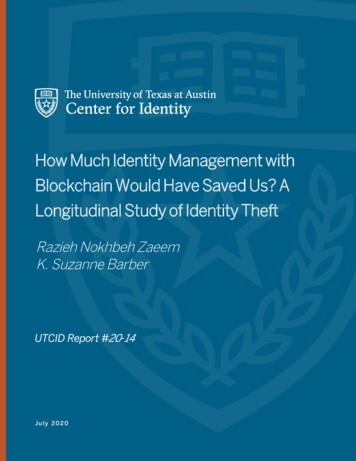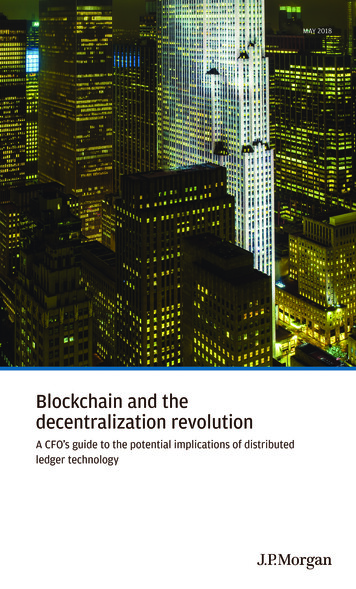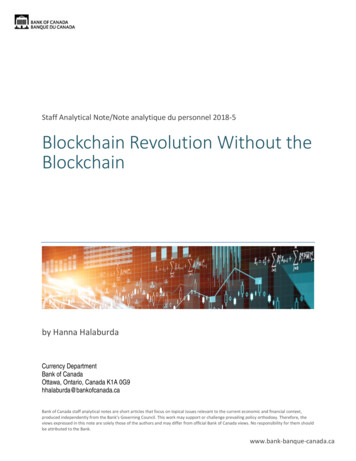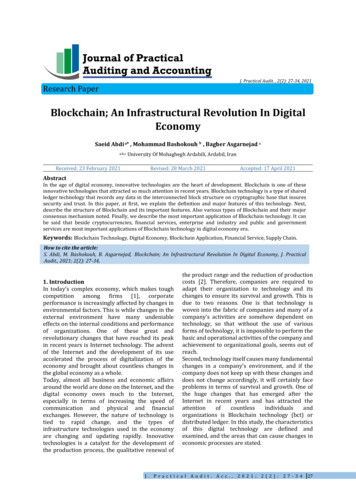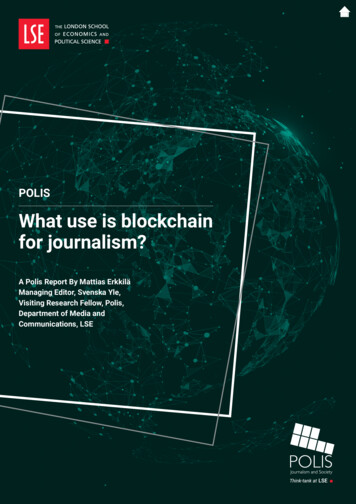
Transcription
POLISWhat use is blockchainfor journalism?A Polis Report By Mattias ErkkiläManaging Editor, Svenska Yle,Visiting Research Fellow, Polis,Department of Media andCommunications, LSE
ContentsSummary11 Do you have a problem? Just put some blockchain on it21.2 What is blockchain?31.3 Blockchain applications41.4 Blockchain in journalism52 Hey, we are using blockchain! (or planning to)62.1 Civil is reinventing the journalistic platform62.2 Kinzen builds a curator-economy92.3 Creating user-generated news agencies112.4 A content marketplace on blockchain143. Have you ever seen the chain?153.1 A centralized system might be better173.2 Everything is possible, nothing is real184 Real problems, fake solutions?194.1 Part of the digitalization process194.2 Web 3.0 will be built204.3 The reality now204.4 Do it now – the tech does not matter215 The ecosystem is important225.1 The idea, not the technology235.2 Users, users, users!23Afterword: Check out Web3!25
SummaryNewsrooms have gone digital, become networked, and sought tobuild engagement and a business on a raft of new platforms andnetworks, using a dizzying range of new tools and software. Thisprocess of adoption and adaption is tiring and depletes resourcesas well as opening new frontiers. It may be that we are in a ‘postenthusiasm’ world when it comes to technology and journalism.However, the idea of blockchain has fired up a vibrant debate abouthow we might change things all over again. Despite being aroundfor years and applied in other sectors, the technology is not widelyused in media production. There are start-ups building solutionswith some minor blockchain applications, such as saving articlemetadata and editing history to an open an immutable repository.There is also an EU-financed project that uses blockchain forcontract and rights management. The frontrunner for journalism onblockchain has so far been US-based Civil that has promised to savejournalism with its blockchain-based platform. But Civil’s recenttoken sale failed. Many were interested to hear about the idea butvery few wanted to back the idea financially. So, it seems that on thehype curve, blockchain might be on its way past the “Peak of InflatedExpectations” and headed to the “Trough of Disillusionment”.This doesn t mean that we should rush to dismiss blockchain.The technology itself appears difficult to understand but I wouldencourage anyone interested to spend some time looking into it. Butmy stronger recommendation is that you get to know the blockchainmovement and what is happening more generally around ‘Web3.0’.We journalists should aim to accomplish all those things that theblockchain start-ups are trying to do: create verified and trustedcontent by opening up our editing histories and make co-creationwith the public a natural and necessary part of journalistic work.This should be done immediately, with or without blockchain.1
This report was produced during my month-long fellowship at theLSE’s journalism think-tank Polis in October 2018. My aim was tostudy the possible uses and benefits the blockchain technology couldhave for journalism. I’ll begin with a look at the technology and thepossible uses we journalists might have for it. Then we will meetsome of the companies planning to use blockchain to enhance orreinvent journalism. These grand plans will be contrasted with criticalviews of the blockchain “hype” and the possible intrinsic problems itmight have. The last chapter will have an analysis and some thoughtsabout what the journalistic community should think about and dowith (or without) blockchain.1 Do you have a problem? Justput some blockchain on itBlockchain is riding high on the hype curve. Enthusiasts claim thistechnology will bring about total change to industries from financeto food. And it doesn’t stop there: aspects of the public sphere fromcommunities, government, politics, voting and decision-making willchange - not to mention how we understand and use our identities, onand offline. In short: it will change everything.That includes journalism1. Even if journalism has not been leadingthe blockchain development, it is definitely not forgotten. There arealready start-ups working on blockchain-based solutions for manyaspects of the media ecosystem: social media platforms, monetizationsystems, rights management, user co-operation and gratification,identity management, archiving and production tools using blockchain.There are also several projects that talk about no less than saving orreinventing journalism with blockchain. And also some of the existingmedia companies have started projects with blockchain.1 ee for example ‘2019 Trend Report for Journalism, Media and Technology’ from Future Today ournalism-media-tech-trends/2
1.2 What is blockchain?Blockchain is a technology that records transactions in a way that isdistributed, immutable and openly available to anyone. In the basicformat it is a chain of blocks that record all the transactions done in thechain and that is saved on all the nodes in the network with the help ofencryption. The nodes share a consensus of the status of the chain andof the following block to be added.There are both public and private blockchains. The public version isopen to everyone to inspect and join.The private versions are usually called permissioned blockchains since apermission is needed to join them.Some blockchains, the best-known being Ethereum, add the possibilityto save and run ‘smart contracts’ on the blockchain. A smart contractcan be a regular financial contract that manages conditions forpayments or, for example, a voting system that controls the wholeprocess from registering voters to declaring the outcome of the vote.These contracts are also immutable and fully automated.3
1.3 Blockchain applicationsTo get a better understanding of the possible uses for blockchain, I citeWilliam Mougayars definition:“Technically, the blockchain is a back-enddatabase that maintains a distributed ledgerthat can be inspected openly. Business-wise, theblockchain is an exchange network for movingtransactions, value, and assets between peers,without the assistance of intermediaries. Legally,the blockchain validates transactions,replacing previously trusted entities.”2The most common application of blockchain is cryptocurrency, likeBitcoin. Blockchain makes it possible to do transactions between twoparticipants without relying on trust and without involving a third party,a bank for example, to guarantee the transaction, so value transactionsare an obvious use case.But as Mougayar points out, the technology can also be used in otherindustries. Walmart is using IBM’s blockchain technology to improvefood traceability. And ING, BNP Paribas and Commerzbank amongothers are creating Marco Polo, an open account trade finance platformon R3s Corda blockchain framework.These applications that are mostly about increasing efficiency do notreally explain what the big hype is all about. The magic word behind thebig visions is ‘decentralization’.If blockchain allows for disintermediating a central authority in valuetransactions, it should logically be able to do the same in other domainsas well: identity management, voting, decision systems, publishingand ownership, to mention a few. Most of the main pillars of society2 Mougayar, William (2016) ‘Working as a layer on top of the internet, blockchain is an instrument of change’ LSE Business ReviewBlog, 7.7.2016. n-is-aninstrument-of-change/4
could become decentralized, which would mean very big changes – atleast, potentially. In her article “Blockchain Dreams: Imagining TechnoEconomic Alternatives After Bitcoin” Lana Swartz notes that “it truly isdifficult to overstate the claims made by blockchain enthusiasts”.31.4 Blockchain in journalismDecentralization might not be the first thing that springs to mind as asolution when you ponder the problems journalism is experiencing. Butblockchain might well have several improvements to offer journalists.Here are some: a widely used cryptocurrency with low or no-cost transactions wouldmake it easier to charge very small amounts for media products. a cryptocurrency or token could also make it easier for mediacompanies to incentivise users for co-operation and content creation. an automated content and rights management marketplace tools for controlling the origin and integrity of content a distributed publishing environment which means that a single serverfailure would not take down the content itself a distributed publishing environment to counter censorship4 a decentralized publishing platform, “Facebook or Google without thecentral ownership and control.”A more decentralized and democratic network than the internet todaywould likely work in the favour of journalistic organisations. Thisplatform, often referred to as Web 3.0, would, for example, allow users toown their identity and data, which would then again level the playing fieldbetween media companies and the internet giants that now control useridentities and user data.34 Swartz, Lana (2017) ’Blockchain dreams: Imagining techno-economic alternatives after bitcoin’ in Another Economy is Possible: Cultureand Economy in a Time of Crisis ed. Manuel Castells. Cambridge: Polity Press, pp. 82-105. One of the first sites to actually use this might be Gab. See: ‘The Alt-Right’s Favorite Social Network Gab’s Plan To Use Blockchain ToMake Itself Indestructible.’ Forbes 31.10.2018. ible/#6eeb4cb631be5
2 Hey, we are usingblockchain! (or planning to)In this chapter we will look at the companies, mainly start-ups, whoare using or planning to use blockchain. We start with the mostambitious, Civil, and its partners Forbes and Kinzen. Then we meettwo start-ups that are working on very similar ideas: Mogul Newsand Nwzer. The last example is an EU-financed co-operation betweenseveral companies, including Deutsche Welle, VRT and WAN-IFRA,working together to create a marketplace where rights managementand the contractual framework would rely on blockchain solutions.2.1 Civil is reinventing the journalisticplatformCivil, a start-up based in New York, uses a simple slogan to describeits goal: ‘Civil is a new economy for ethical journalism’. In practicethis means that Civil is simultaneously trying to find a solution tothree major problems journalism faces, according to Dan Kinsley,co-founder and engineering lead:“The problem of trust, the problem ofmonetization and the problem of ethicalgovernance of the publishing platform.”5To fix all this, Civil has created a framework that includes more orless everything a journalistic project needs to function: publishingtools and platform, a token-based monetization system and a5 Interview with Dan Kinsley 13.10.2018.6
governance model to guarantee that newsrooms in the Civil networkfunction ethically and follow journalistic standards. The majorinnovation in the model is the token-based governance system thatallows the public to financially back selected newsrooms and takepart in the key decisions regarding the platform.“Civil is an economy”, explains Kinsley. “It now has three parts: theCivil network that is shared by everyone, the Civil Media companythat has created the platform and will continue to create serviceson it and then there is the Civil Foundation that looks after theintegrity of the platform, funds new newsrooms and research andappoints the members to Civil Council which is the ‘supreme court’of the Civil Registry.”And what is blockchain’s role in all this?On the general level Civil is a supporter of the decentralizationmovement. “Blockchain is about decentralization, a way to transferpower away from the big companies”, Kinsley says.Also on the technical level Civil is very deeply attached to theEthereum-blockchain:“The core of Civil’s journalism protocol is builtupon smart contracts written for the Ethereumblockchain. These contracts provide interfacesto access the token curated registry, newsroomdata and other components of the marketplace.”6In other words blockchain is a key component of Civil’s technology.The economy is based on cryptocurrency, the governance isprogrammed in smart contracts and the content metadata is savedon the blockchain.The newsrooms in the network do not need any knowledge ofblockchain. Technically a newsroom only needs to use Civil’s owncontent management system or use a plugin. Civil is providing aplugin for Wordpress.6 Ng, Peter. ‘Introducing the Civil Events Crawler’, Medium, 6.8.2018. vents-crawler29fe05d3f8617
“The plugin communicates with our system and gives thepublishers, articles a Civil hash and metadata. For the public itshows a “runs on Civil” -sign on the article which gives the article ahigher trustworthiness and a larger distribution”, said Kinsley.This is the model that Civil’s first major co-operation with Forbes,will use. Civil also has a co-operation agreement in place with AP.The newsrooms now publishing on the Civil network, called “firstfleet” by Civil, are mainly small, local or niche newsrooms, many ofthem funded by Civil.Civil also points out that the newsrooms can and will acceptfinancial support in other currencies than CVL-tokens, for examplein dollars. This is probably sensible since Civil’s own token sale inSeptember-October did not succeed. It raised only 1.4 million whenthe minimum target was 8 million. The token sale was criticised forbeing too complex and Civil’s governance model, particularly the CivilCouncil was questioned.7 Civil says it will proceed without the tokensand a new, simplified sale will happen later.Kinsley is hopeful about the future:“I believe that this opens up new ways toconnect with your public. Newsrooms areheld directly accountable to the users of theplatform which makes users a part of thecommunity and more likely to commentand co-operate with the journalists.”He also believes that Civil could become a platform for othersto build on.7 For example ‘Sorry Civil, ‘crypto-economics’ and ‘constitutions’ won’t save journalism’, Financial Times, 12.10.2018. ons--won-t-save-journalism-/8
2.2 Kinzen builds a curator-economyOne of the companies planning to work with Civil is Kinzen who arebuilding a new sort of news app that combines user-oriented (asopposed to revenue-oriented) personalisation with a curator network.Kinzen’s plan is to reward the curation work. “The people that createvalue never get anything”, says founder and CEO Mark Little, meaningall those who run more or less curated services like newsletters ondifferent existing platforms.First the curators will get free access to the news app that Kinzen isplanning to launch in January 2019. The second step will be a tokenbased reward. Kinzen is exploring commercial opportunities forcurators within Civil’s journalism ecosystem, and codes of conductfor a curator network, which mirror the Civil constitution. Littlesays Kinzen has no plans to leverage other elements of blockchaintechnology beside token-based incentives, but does not rule it outin the future.Mark Little, Kinzen9
“Increasing reader trust throughtransparency”Salah Zalatimo, Senior Vice President of Product & Technology at Forbes,explains why Forbes is testing Civil’s technology for appending articlemetadata to a blockchain.1. Can you be more specific about Forbes goals with the project? How doyou measure them? Trust, for example.Our primary goal is to learn. Blockchain technology is complex and hasgrand promises. One of the more immediate benefits is around increasingreader trust through transparency of authorship and accreditation. We runuser surveys once per quarter to assess various elements of our brand,and trust is one of the questions we will be tracking.2. Does Forbes have other blockchain-related projects in production orplanned? Or if not, what do you think you should be looking to do?At this point, this is the only blockchain technology project we haveplanned. As it is exploratory, it may well lead to others.3. What would you recommend as a good starting point/test project/environment for a media company new to blockchain?I think what we are doing with Civil is a great first step – appending articlemetadata to a blockchain so that authorship and other characteristicscan be permanently established and publicly available. This validates thesource and, to some extent, quality of the content.4. In the long term, would Forbes be interested running its services on aa) distributed technical platform?b) decentralized media platform?a) Yes.b) Yes.Both of these technologies have inherent benefits – elimination of singlepoint of failure. As we gain exposure to them, we’ll be able to better assessthe feasibility of doing so.10
2.3 Creating user-generated newsagenciesThe idea of co-operating with the users seems to fit well withblockchain. Both London-based Mogul News and Maastricht-basedNwzer are start-ups working with their own version of doing newstogether with the public.Mogul NewsMogul News is building a news service that plans to combineprofessional journalism with input from the users. The founder RavSingh Sandhu sees many advantages in this model:“Some people are more willing to use their timethan their money to pay for something theyappreciate so we are letting people pay for MogulNews through their work. If you do not want topay you can share, recommend or comment.”Rav Singh Sandhu, Mogul News11
Blockchain technology plays a minor role in Mogul News’s techstack: “We will use blockchain to save and publish the whole editinghistory for every article. It is key to trust”,For Sandhu, Mogul News is about renewing journalism: “Journalismis a public good in private hands and it is very important thateveryone has access to high quality news”.His long-term vision is to create a “fully autonomous, selfgoverned and truly decentralized news network” that pays thecontent producers. “People could for example produce local newsthemselves, which would be important to get more marginaldemographics interested in the content”.Mogul News will launch sometime before summer 2019 and saysthat it already has over 2,500 people who want to take part inproducing and editing the content.12
NwzerDutch start-up Nwzer is on a similar track. According to Nwzer’swebpage the goal is to build the “first user-generated news agency”.Founder Karim Maassen talks about a platform that combines citizenjournalism with artificial intelligence and blockchain. The basic ideais that the community creates content on the Nwzer platform andthen an algorithm creates the service, basically a webpage, from thatcontent using different data points:“One of the most important indicators ofquality content is the reputation of the creator.This we have seen in our tests very clearly.”This is also where blockchain enters the picture. “We use theEthereum blockchain for recording everything, all the user actions,and also the reputation score.” Other plans around blockchainare still open. “We might issue tokens, but they will be the exactreputation score. We like to add value to the system based on itspurpose, rather than an ICO where it’s basically just crowdfunding.”The next step is Alpha-testing with a small user group. Nwzer alsohas several partnerships going on. “During the spring we will launchour service as part of a digital service run by a big Dutch mediacompany” saysMaassen. ForMaassen the mostimportant thingis journalism.“I believe in this.It is importantthat people areinformed.”Karim Maassen, Nwzer13
2.4 A content marketplace onblockchainThe European Union is financing a co-operation project called ContentPersonalisation Network. The ambitious project with 9 partners,including VRT, Deutsche Welle and WAN-IFRA, aims to “providemedia users with a seamless and reliable news experience ondifferent platforms and provide media companies with effective newsdistribution solutions”.The project applies blockchain technology for contract and licencemanagement, which forms a part of the platform. “Publisherswill use content licensing templates on the CPN marketplace andcontent producers can accept them more easily”, says RobertLearney, who works as a lead technologist at one of the CPNpartners, Digital Catapult.8An open, more or less automated marketplace without third partyinvolvement promises to reduce lengthy negotiations and costs forboth publishers and producers. It also gives the publishers a forumwhere they can ask for or order certain kinds of content, for exampleimages, without contacting several producers individually.The chosen blockchain platform is Hyperledger Fabric which isa private blockchain first created by IBM. “On Ethereum there isno control over who can validate your transactions so a privateblockchain is better, at least for now”, Learney says.Learney is hopeful about blockchain as a technology but suggeststhat everyone should test it first. “Choose a small problem. And dothe test together with an external partner, that is the only way tounderstand the potential advantages – and disadvantages.”8 Interview with Robert Learney 10.10.2018.14
3 Have you ever seenthe chain?The bold statements and grand plans of blockchain visionaries andentrepreneurs have been criticised. One of the more vocal critics is DavidGerard, writer of the book Attack of the 50-foot Blockchain. He arguesthat blockchain has in fact been around from 1970s. “It is basically anadd-only, tamper-free log - widely used when it has a use case.”9Gerard adds that these use cases are few. And in those cases when ablockchain is used, it actually functions as a database, not as an open,public ledger.“Blockchain is a weird package ofpromises of great things happening.”David GerardDavid Gerard (credit: Pauline Martindale)9 Interview with David Gerard, 13.10.2018.15
Dhruv Ghulati, founder of Factmata, has an even more pragmaticview: “Have you seen a blockchain in production?”10Factmata is a startup that gives news articles and other content acredibility score based on an automated and machine learning-guidedreview – an idea that we have already seen high on the list of possibleuses for blockchain in media. But Factmata does not use blockchainat all even though Ghulati underscores that they strive to make theirdata openly available:“Blockchain is still not in vogue for the communities we are trying totarget, and the setup costs are known to be very high to get started not wise for an early stage media project in our opinion”Dhruv Ghulati, founder of Factmata10Interview with Dhruv Gulati, 26.10.2018.16
3.1 A centralized system might be betterIn her article “Blockchain revolution without the blockchain” HannaHalaburda notes that the main concept blockchain seems toincorporate is encryption and smart contracts.11 Encryption andsmart contracts might bring benefits but these technologies do notneed blockchain: “In many cases the permissioned blockchains arethe right tools for their purpose, but more often a centralized systemwould be more efficient and reliable”, Halaburda writes, meaning thata centralized storage, usually a database, would be a better choicethan a distributed blockchain.Kai Stinchcombe, founder of True Link Financial, goes further:“Everyone says the blockchain is going to change everything.And yet, after years of tireless effort, nobody has actually come upwith a use for the blockchain – besides currency speculation andillegal transactions.”121112Halaburda, Hanna (2018). ‘Blockchain revolution without the blockchain?’ in Communications of the ACM, 61(7), pp. 27-29. Stinchcombe, Kai. ‘Ten years in, nobody has come up with a use for blockchain’ Medium, 22.12.2017. -up-with-a-use-case-for-blockchain-ee98c18010017
3.2 Everything is possible, nothing is realFor blockchain promoters, the limited amount of real use cases is nota problem since it is just a matter of time. The fact that the visionsfly high even though reality is lagging far behind is, according to LanaSwartz, a characteristic of the whole blockchain movement:“As a soon as a proposal is offered – whetheras a white paper, a slide deck, or a blog post – itis as though it already exists, ready to go.”13Swartz also notes that it is not unusual for Silicon Valley thattechnology is one step behind the promises but “ blockchainadvocates are unusually willing to operate as though the futurearrived in the present”.14For David Gerard the question is more about fantasy than futurism:“Smart contracts are computer programs but in white papers they aretreated like magic”, he says, implying that the future deliverables ofblockchain technology might not be available in our reality no matterhow long we wait.And to those saying that this is just like the early days of the internet,meaning big promises but bad user experiences, Gerard has this to say:“The internet was real, based on successesand real people using it. Blockchain usesthis argument as an excuse for failure.”1314Swartz, 2017, p. 89.Swartz, 2017, p. 98.18
4 Real problems, fakesolutions?So how should we interpret these contrasting messages from thepoint of view of media companies and journalists? On the one handwe have the whole vibrant blockchain movement and establishedfigures, like Amy Webb, saying that journalistic organizations should“act now”15 when it comes to blockchain. And on the other we havecritics saying that blockchain is nonsense.4.1 Part of the digitalization processI would like to follow Robert Herians’ advice that blockchain isan influential yet subtle force changing our society and it “can nolonger be ignored”.16 Odysseas Sclavounis, who studies the internalgovernance models of existing blockchains, makes a similar pointin saying that blockchain should be seen simply as one step in theongoing digitalization process: “Blockchain will become the backgroundstructure for how we interact with data, even if the use cases are hardto see now. It is an inevitability, but not a systematic change.”17According to Sclavounis, the new decentralized web services thatare under construction at the moment will not supplant the nowdominant, centralized services like Facebook and Google: “These twomodels will largely co-exist and the bigger platforms will be influencedby the newcomers – a bit like the far right political parties caninfluence the bigger parties in the centre.”151617 ‘2019 Trend Report for Journalism, Media and Technology’ from Future Today Institute. dia-tech-trends/Herian, Robert (2018). ‘Taking blockchain seriously’ in Law and Critique, 29(2), pp. 163-171.Interview with Odysseas Sclavounis 26.10.2018.19
4.2 Web 3.0 will be builtThe technical experts seem to regard blockchain as a something thatwill have real consequences. “Web 3.0 is being built and blockchainwill be part of it, just how big an impact this will have is unclear at themoment”, says Robert Learney from Digital Catapult.Learney expects that private blockchains will be the catalyst. “Biggercompanies will begin to use private chains first. Then when thatusage is widespread, we will see start to see them transition toservices also on public blockchains.” Even the blockchain-scepticDavid Gerard admits that “in 5-10 years we might have systems thathave something blockchain-based. It will not work well, but it will bekept because it’s better than not having it.”4.3 The reality nowTo return to the reality now, it seems clear that the use of blockchainin production systems is quite low, close to non-existent. Even thestart-ups we met earlier in this report have very modest plans forblockchain applications:Company Blockchain applicationsCiviltoken, governance with smart contracts, rmetadataCPNrights management and contracts with smart contracts20
Even if blockchain does not have the power to reinvent journalism,it can be used for several purposes: increasing transparency and trust with openly available andimmutable metadata including the editing history of a certaincontent piece sharing value with the user community or to reward for usergenerated content automated contract and rights management.4.4 Do it now – the tech does not matterAll those things can also be done without blockchain. And this is avery important point since it is critical for our industry to proceed fromelevated discussions about misinformation and technological silverbullets to actually test real tools that could make a difference.Forbes for example shows an interest in doing just that. And whilesome may feel schadenfreude over set-backs to projects like Civil,we should remember that traditional media’s problems are very realand have to be solved. If blockchain can provide tools, we shoulduse them.The potential to save article metadata seems to be a good usecase for blockchain for journalistic purposes. This is not somethingthat journalists are used to and some might actually feel intimatedif we were to expose editing histories for everyone. But as Forbes’Salatimo says: “This validates the source and, to some extent, thequality of the content.”Automated content marketplaces and copyright clearinghouses withvery low transaction fees would be interesting for many publishersand producers. If they can be done effectively using a privateblockchain, it would be also be a use case for the technology.21
5. The ecosystem isimportantJournalism might have something to gain from the blockchainmovement – even if the technology only
aspects of the media ecosystem: social media platforms, monetization systems, rights management, user co-operation and gratification, identity management, archiving and production tools using blockchain. There are also several projects that talk about no less than saving or reinventing journalism with blockchain. And also some of the existing

